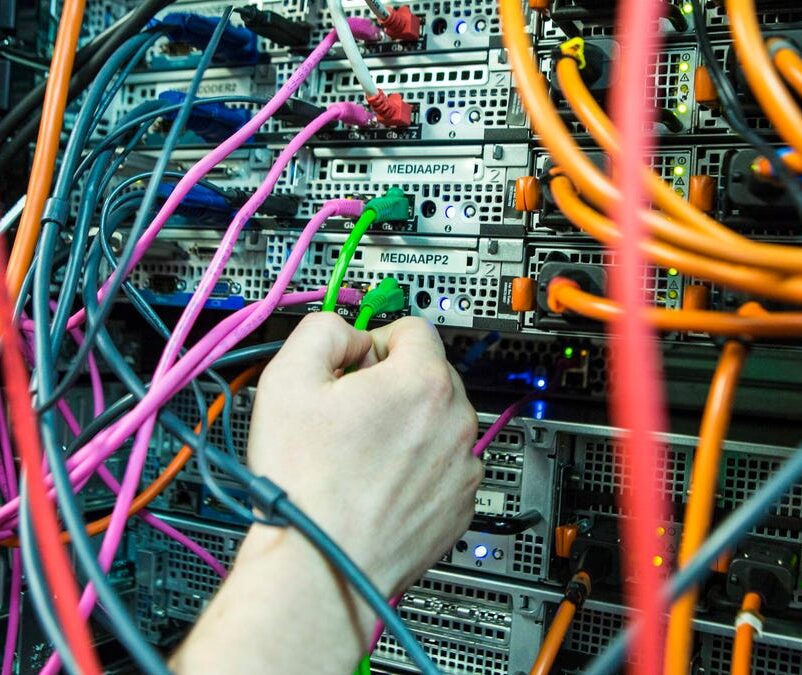
NUREMBERG, GERMANY – MARCH 01: A technician checks a DC/DC half-shell, which converts 450 V to a … [+]
Welcome to the wild world of software and carbon emissions, where the digital infrastructure of organizations is a hungry beast, consuming vast amounts of electricity and leaving a trail of greenhouse gas emissions in its wake.
The issue is becoming more pronounced as the world accelerates its adoption of artificial intelligence and businesses increasingly rely on software to drive their operations.
Picture a data center, a fortress of technology where much of today’s software is housed. These sprawling structures gobble up electricity with reckless abandon, with worldwide consumption estimated to be between 220 to 320 terawatt-hours in 2021, according to the International Energy Agency. That’s more power than consumed by entire countries such as South Africa, Sweden, or Egypt. The technology and telecom sector generates an estimated 5% of global CO2 emissions, twice as much as the whole of the aviation sector, and this figure is set to surge to as much as 14% by 2040 up.
But the problem doesn’t stop at data centers. The move to cloud computing has only made it more challenging to measure emissions, with companies having to rely on their cloud providers for measurement tools that may not accurately reflect energy usage.
Cloud computing enables the hungriest, most processor-intensive task that most firms undertake: training AI models. This is where AI “learns,” discovering the hidden rules and connections inside a mass of data.
Meanwhile, emissions from network equipment are even higher than from data centers, and network providers have been slow to offer calculators to help organizations track their emissions. And what about software run on hardware owned by customers or other users? Companies have very little data on this equipment, making it even more difficult to calculate emissions.
Technology has brought immense benefits to our daily lives, but as our reliance on technology grows, so too does the carbon footprint of the industry. The auto industry is addressing carbon emissions through innovative technologies and eco-friendly practices. The tech industry remains tilted toward a mass ecocide.
With AI becoming more valuable in real-world applications and its computational load increasing, the time is ripe for sustainable software. By building software with sustainability in mind, companies can avoid costly and complex rework down the line when the issue inevitably climbs the priority list.
One of the first steps in reducing the carbon footprint of technology is to be explicit about the issue of pollution. Many people do not realize the impact that their technology usage has on the environment. By highlighting the unnecessary power consumption of technology, such as high frame-rate security video versus a lower frame rate or websites set to refresh more frequently than necessary, we can begin to change people’s perceptions about their technology usage.
Thanks to public education, people now take fuel consumption into consideration when buying a car. Imagine if people had to take their computers to the gas pump? By raising awareness, we can teach people to take power consumption into account when using electronics.
To effectively reduce the carbon footprint of technology, it is essential to have accurate measurements in place. Without such measurements, it is impossible to understand how power is consumed by individual systems when infrastructure is shared.
Another important lever to reduce the carbon footprint of technology is to improve coding behaviors. Optimizing the various components of Natural Language Processing, including data storage, processing, and infrastructure, for example, can have a significant impact on reducing the carbon footprint of that technology.
The issue of software emissions is becoming more pressing as companies accelerate their deployment of artificial intelligence, whose computational load is increasing exponentially as it becomes more valuable in real-world applications. Organizations risk developing software that will run hot unnecessarily for many years if they do not improve the sustainability of their software today.
Optimizing code and algorithms is a key lever to reduce emissions. In fact, depending on techniques used and optimization of training methodology, the amount of energy used to train an AI model can be divided by a factor of 1000 for the same results. For example, the University of Massachusetts, Amherst found that training one model could generate up to 280 metric tons of CO2 (equivalent to 470 people taking return flights from New York to San Francisco), while Google for the same results stated it could produce the training with 0.000083% of these emissions.
Finally, it is important to choose the right servers and providers to host our technology. Companies such as Amazon Web Services (AWS) and Google are now choosing green sources of energy to remain competitive, and this trend is likely to continue. As public awareness grows, low power consumption and green energy sources will become a key differentiator for both infrastructure companies as well as end users.
By choosing servers and providers that prioritize sustainability, organizations and individuals can further reduce their carbon footprint and make a positive impact on the environment.
Fortunately, technology players are starting to react. The Green Software Foundation has created a Software Carbon Intensity index to encourage developers to work more efficiently. It sets technical specifications to calculate the carbon emissions for which a software application is responsible.
Carbon-aware applications are also on the rise to provide users with real-time information on how to reduce their consumption. Hosting companies are being encouraged to make the emissions associated with each use more transparent and to increase competition for access to low-carbon electricity.
While the tech industry is starting to move, the first step is changing people’s perceptions about their technology usage. Raising awareness is critical, both among individuals and professionals. Companies must adopt more responsible data storage practices and users must adopt eco-friendly digital habits. It’s a start to turn off computers at night, but our digital behavior must change to reflect the same eco-consciousness that we exhibit in our everyday lives.
Most people would recognize the wastefulness of driving kids to school in a truck with the windows open and air-conditioning on. We need that same public awareness for technology’s energy consumption. No longer can we indulge in waste and excess. It’s time to take control of our digital carbon footprint.
The solution may seem elusive, but with measurement, innovation, and determination, we can build a future where software drives organizations forward, not backwards. It’s time for sustainable software, before the cost of fixing the problem rises like a giant beanstalk and the beasts within our data centers consume us all.
__



